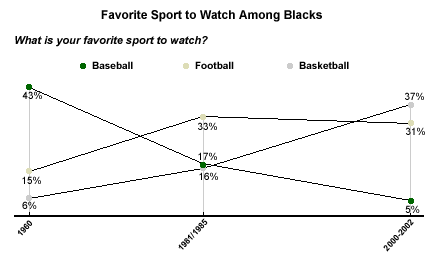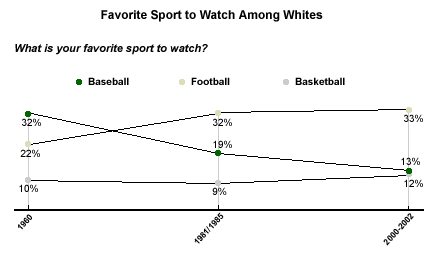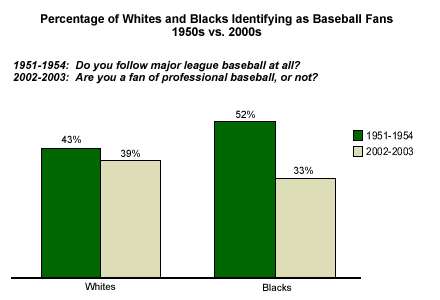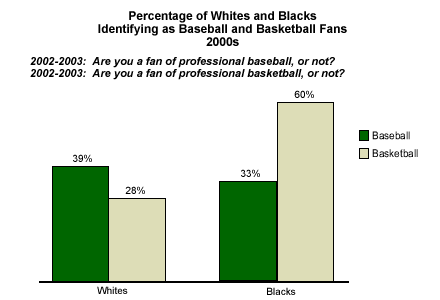GALLUP NEWS SERVICE
A recent controversy in the sports world concerns the declining percentage of black baseball players in Major League Baseball (MLB), while blacks are increasing their numbers in other professional sports leagues. A recent Sports Illustrated article points out that just 1 in 10 MLB players are U.S.-born blacks, down from 27% in 1975. Meanwhile, the percentage of blacks in the National Football League (NFL) and National Basketball Association (NBA) are holding steady or increasing -- currently, a majority of both NFL and NBA players are black.
When Major League Baseball's All-Stars meet Tuesday to play this year's Mid-Season Classic, relatively few blacks will probably be watching. Gallup's historical data shows a dramatic change in blacks' sports preferences over the years, and shows that baseball appeals to fewer blacks today. It's unclear whether declining black interest in baseball is a cause or an effect of the scarcity of black major leaguers, but the two are definitely related.
For many years, Gallup has asked Americans which sport is their "favorite sport to watch." Baseball, long known as the national pastime, easily topped the list from 1937-1960, with slightly more than one in three Americans naming it as their favorite sport. But a 1972 Gallup Poll showed football overtaking baseball as Americans' favorite sport, a distinction it continues to hold today. Meanwhile, the percentage claiming baseball as their favorite sport has continued to decline, while basketball and auto racing are increasing their popularity. Gallup's most recent data, from December 2002, show 37% of Americans saying football is their favorite sport, followed by basketball at 13% and baseball at 12%.
Changes in Blacks' Favorite Sports
Beneath the surface of these data lies a dramatic change in blacks' sports preferences. A 1960 Gallup Poll found 43% of blacks naming baseball as their favorite sport, significantly higher than the national average of 33%. Jackie Robinson's entry into the game in 1947 opened the way for such talented black players as Willie Mays, Hank Aaron, Ernie Banks, and Frank Robinson -- men who made their mark on the game and helped attract the support of black fans.
In subsequent years, blacks mirrored the rest of the nation -- they moved away from baseball as their favorite sport, but at an even faster rate. A combination of two Gallup Polls conducted in 1981 and 1985 showed only 17% of blacks saying "baseball" was their favorite sport in those years. That shows a 26-point drop in the percentage of blacks naming baseball as their favorite sport, twice the drop of white interest (from 32% to 19%) during this same period.
By the mid-1980s, football had become blacks' favorite sport (as it had for whites), but basketball had overtaken baseball as the second favorite sport among blacks. Julius "Dr. J" Erving, Earvin "Magic" Johnson, and later Michael Jordan, attracted greater number of fans, especially blacks, to the game of professional basketball. And by the late 1970s, the vast majority of professional basketball players were black.
The most recent Gallup data, from a combination of 2000-2002 Gallup Polls, shows an even further decline in blacks' ranking of baseball as their favorite sport. Only 5% of blacks now say baseball is their favorite sport, while 31% say football, and 37% say basketball.

The historical pattern among whites is similar to blacks' in that more whites say football is their favorite sport than say baseball -- in fact, the percentage preferring football is about what the percentage preferring baseball used to be. Interestingly, the percentage of whites saying basketball is their favorite sport has changed little over the last several decades. The rise of basketball on Americans' list of favorite sports to watch is due mostly to the dramatic increase among blacks.

The Disappearing Black Baseball Fan
Gallup data also show that the percentage of blacks identifying themselves as baseball fans -- regardless of whether it is their favorite sport -- is declining. A compilation of Gallup Polls conducted between 1951 and 1954 found 52% of blacks saying they "followed major league baseball." The most recent data, from a combination of 2002-2003 polls, show just 33% of blacks say they are "a fan of professional baseball." Whites show only a small change during these years, from 43% in the 1950s to 39% in the present day.

Given that basketball is the favorite sport among blacks, it is not surprising that blacks are nearly twice as likely to identify as fans of professional basketball (60%) than baseball (33%) according to Gallup Polls conducted between 2002 and 2003. [NOTE: Gallup did not ask the football fan question enough during this time to provide reliable estimates by race.] Among whites, just 28% identify as pro-basketball fans, significantly fewer than the 39% of whites who say they are baseball fans, and less than half the proportion of black basketball fans.

Why the Disparity by Race?
There are many reasons for declining black interest in baseball. One is the sheer number of black athletes in basketball and the dwindling number of blacks in baseball, as Sports Illustrated mentioned. Many of the most prominent basketball players today are black, such as Shaquille O'Neal, Kobe Bryant, and Allen Iverson. In fact, 75% of the players in this year's NBA All-Star game were black. By comparison, only 15% of the players on the MLB 2003 all-star game rosters are blacks born in the United States. And while many recognize Barry Bonds as the greatest baseball player in the game today, many of the most prominent baseball players these days are white or Hispanic.
A second reason is the lack of baseball facilities and programs for kids and amateurs in urban areas where many blacks live. If younger blacks had opportunities to play baseball, they probably would be more likely to become fans of the sport. According to the Sports Illustrated article, no black from Boston, New York, or Philadelphia currently plays in Major League Baseball. Although the sport has programs to encourage the development of baseball in urban areas, many of the kids who participate in these are Hispanic. Baseball also requires a greater number of players to play, while basketball can be played competitively with as few as two players. Baseball also requires more equipment to play than basketball does, which could pose a barrier to those in poorer areas who don't have the money for bats, gloves, and balls.
There are certainly many other reasons why blacks are less likely to be baseball fans than in the past. But the decline is unmistakable, and it bears watching whether Major League Baseball can reclaim its interest among black Americans.
Survey Methods
Data are drawn from the following sources (maximum margins of sampling error in parentheses):
Favorite Sport data:
A Dec. 8-13, 1960 Gallup Poll of 2,846 national adults, including 2,416 whites (±2)and 332 blacks (±6).
A combination of Gallup polls of 1,540 national adults, conducted Jan. 9-12, 1981, and 1,536 national adults, conducted July 12-15, 1985. The combined sample includes 2,762 whites (±2) and 283 blacks (±6).
A combination of Gallup polls of 998 national adults, conducted Mar. 30-Apr 2, 2000; 1,024 national adults, conducted Mar. 26-28, 2001; and 1,001 national adults, conducted Dec. 5-8, 2002. The combined sample includes 2556 whites (±2) and 243 blacks (±7).
Baseball Fan data:
A combination of Gallup polls of 2,013 national adults, conducted July 8-13, 1951; 2,056 national adults, conducted March 27-April 1, 1952; 1,536 national adults, conducted September 12-17, 1953; and 1,530 national adults, conducted July 16-21, 1954. The combined sample includes 6,680 whites (±1) and 374 blacks (±6).
A combination of Gallup polls of 1,008 national adults, conducted January 11-14, 2002; 1,011 national adults, conducted March 22-24, 2002; 800 national adults, conducted June 7-8, 2002; 1,004 national adults, conducted July 26-28, 2002; 801 national adults, conducted August 19-21, 2002; 1,014 national adults, conducted November 8-10, 2002; 1,029 national adults, conducted June 9-10, 2003; and 1,003 national adults, conducted June 27-29, 2003. The combined sample includes 6,538 whites (±1) and 591 blacks (±6).
Basketball Fan data:
A combination of Gallup polls of 1,009 national adults, conducted March 18-20, 2002; 1,020 national adults, conducted June 21-23, 2002; and 1,019 national adults, conducted May 30-June 1, 2003. The combined sample includes 2,589 whites (±2) and 234 blacks (±7).
